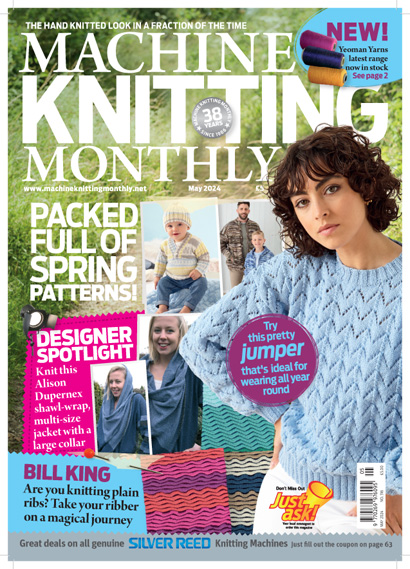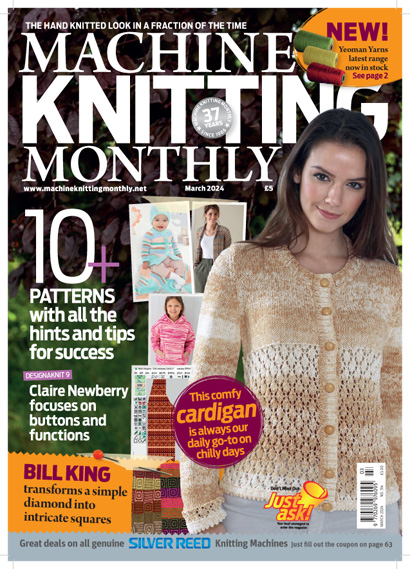
Dear Readers
I’d an unexpected trip down memory lane this month when I found, quite by accident, the design you’ll see on Page 22. I’d decided to check if an old lever arch file was empty before I reused it and, hidden in the index, I came across this Joan Lafferty design. Always the first to be practical, her cardigan is as suitable for using up oddments today as it was back then. She’d thought through needing a decent amount of main yarn, some self-striping yarn and a few colours to pull it all together. I’ve included it not so much as an easy design to knit, but more to show beginners how an ordinary and, dare I say, a rather boring stitch pattern can be transformed with a few oddments from a stash. As we’d expect, Joan used the full width of the needlebed to give the largest size range and, once again, I’m very happy to say ‘thanks for the memories, Joan’.
Sally Butcher, like many of us, has been kept indoors recently by days of pouring rain and lashing winds. The advantage is that she’s had plenty of time to knit and she’s given us lots of ideas and useful tips in Dear Anne. She’s uploaded her patterns on Facebook and the Machine Knitting Beginners & Returners Circle. Sally has also passed on the very unwelcome news that machine knitting groups on the internet have recently been targeted by scammers. They’re offering what looks like a bargain of a machine, for the cost of shipping only. The buyer pays, then no machine arrives. Sally tells us they’ve been taking steps to exclude the scammers from her groups. However, please heed the warning and take extra care if you’re buying online. The old saying goes: “If it sounds too good to be true, then it probably is” and it definitely applies here.
You’ll read in Clubline that the Fashion & Textile Museum in London is looking for volunteers. The time commitment is usually for the duration of an exhibition, around four to six months. Volunteers must be over 18 and asked to commit to volunteering one day a week, on the same day every week, from 10.30am to 6.00pm including a one-hour break. The museum is open Tuesday to Saturday inclusive and volunteers are unpaid, but travel reimbursement is available. If it’s of interest, find full details at https://fashiontextilemuseum.org Finally, do remember that Heathercraft Machine Knitting Centre has now closed down so, until next month, Knit happy!
NEXT ISSUE June 2024
Subscription copies sent out Thursday 2nd May
On sale Thursday 9th May
Ask your newsagent to reserve a copy or order a subscription NOW!



